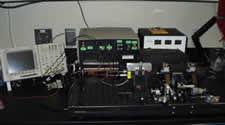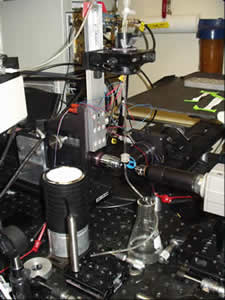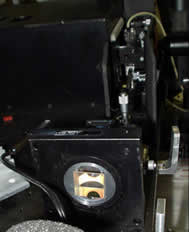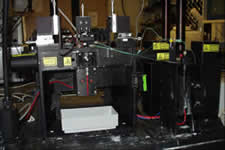Custom Instruments
High Sensitivity Flow Cytometer

Bacteria are at the lower limit of what most commercial flow cytometers can detect. In contrast, this instrument uses very low excitation power (typically < 2 mW @ 532 nm) and high sensitivity fluorescence detectors (including photon-counting APDs) but it can detect very small particles (100 nm dia. beads) or very weakly fluorescent particles. This is due primarily to Its slow flow velocity (typicall 1 cm/sec). This instrument has been used primarily to measure the length of individual DNA fragments; the resulting histogram shows a series of peaks, similar to what you would see on a gel running restriction fragments. The benefit is that much less DNA is needed, and it takes only minutes to run a sample. We are currently investigating the analysis of other small particles, including individual mitochondria and intact viral particles.
 Fluorescence Lifetime Flow Cytometer
Fluorescence Lifetime Flow Cytometer

One problem that researchers commonly come across in flow cytometry are dyes with over lapping spectra, this leads to complicated compensation matrices or inability to use certain dyes. The fluorescence lifetime flow cytometer takes advantage of another property of dyes, their fluorescence lifetime. By using a modulated laser beam this instrument is able to detect the phase shift of the light emitted by a fluorescent dye, and then to calculate the fluorescence lifetime. If two different dyes have overlapping spectra but different lifetimes they can be easily separated. The instrument can also be used to directly measure the fluorescent lifetime and to separate fluorescence of a label from autofluorescence or light scatter.
ORCAS

ORCAS (Open, Reconfigurable Cytometry Acquisition System) is the NFCR's new digital data acquisition system. TRAViS (Tailorable Rapid Acquisition and Visualization Software) is used to display and analyze the data generated by ORCAS, and saves the collected data into standard FCS 3.0 data files which are compatible with commercial analysis packages. ORCAS has been designed to support the unique instrument capabilities in the NFCR. This is a highly adaptable system that has been tested on several of the NFCR's custom as well as commercial instruments.
Acoustic Flow Cytometer

Although hydrodynamic focusing used in traditional flow cytometers is a very effective approach to position particles for analysis, the use of sheath increases assay cost and reduces instrument utility for field and autonomous remote operations. The acoustic flow cytometer utilizes acoustic excitation, generated along the entire structure of a capillary tube, to both focus and concentrate sample particles to the interrogation region. Because acoustic methods both focus and concentrate particles, it is possible to maintain both conventional particle analysis rates as well as long transit times while using a fraction of the power and consumables of a conventional flow cytometer. The longer integration time allows conventional particle analysis using data acquisition systems that are less expensive, smaller and require less power, while still performing high sensitivity measurements. However, the benefits of acoustic focusing flow cytometry are not restricted to only the elimination of sheath fluid. Acoustic concentration also enables the analysis of extremely dilute samples on the order of several cells or particles per liter, as might be seen in a water monitoring application, at reasonable analysis rates. Since there is no sheath, it is also possible to repeatedly reanalyze particles of interest for reliable rare event analysis.

Spectral Analysis Cytometer
We have built a full-spectral analysis flow cytometer with a wavelength resolution of ~2 nm over the range of 350-800 nm and a single particle intensity sensitivity of ~150 MESF of FITC. The spectral separation optics and light collection are modular, allowing implementation of this design on a standard flow cytometer flow cell. There are several types of analytical measurements that will benefit from our more comprehensive and flexible approach to spectral analysis including: spectral deconvolution of overlapping emission spectra, fluorescence resonance energy transfer measurements, metachromic dye analysis, free versus bound dye resolution, and Raman spectroscopy.

Rapid Mix Flow Cytometer
Molecular interactions occur at a high rate of speed. The earliest analysis point is limited to the speed at which the sample can be introduced in to the flow cell. The Rapid Mix Flow Cytometer has a injection point which allows mixing of one reagent to another within the sample line directly before the flow cell. The injection point is variable, which allows for the user to vary the amount of time a sample is mixed prior to analysis, the shortest being 120 ms.